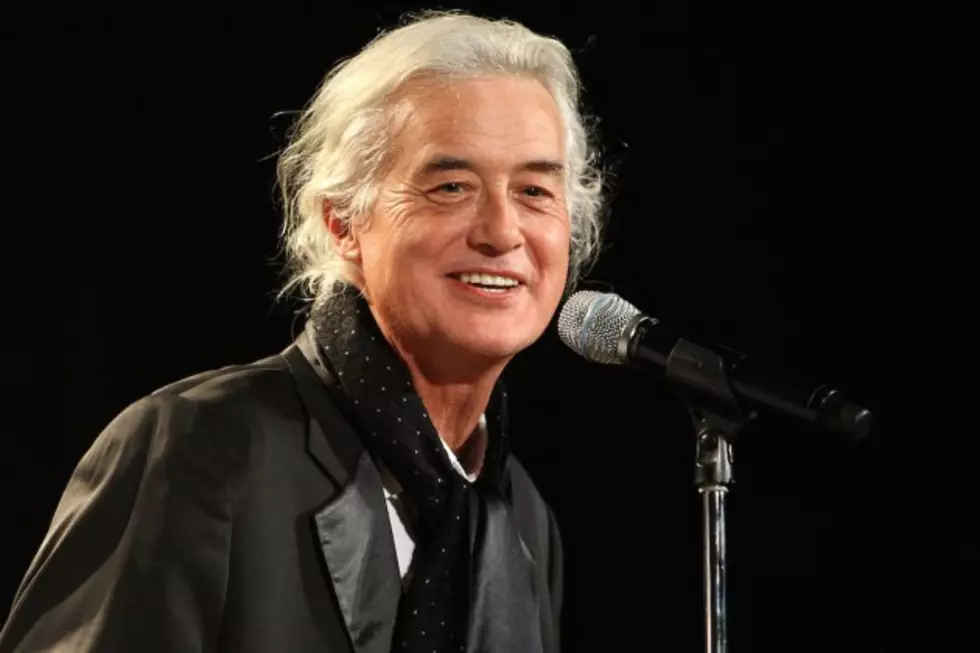Why Graffiti artist Jimmy Page can’t leave his Led Zeppelin legacy alone
The guitarist has been ceaselessly burnishing his glory years, crafting monuments to an already monumental career.
:quality(70)/cloudfront-eu-central-1.images.arcpublishing.com/thenational/25Z5EDLFCRYCPVFZZKRG4UCIVM.jpg)
Alegendary band is rather like a planet: it’s big, and it’s generally made of heavy rock. It also exerts a gravitational pull from which it is difficult to escape. That is most certainly the case with Led Zeppelin, musically and financially speaking the heaviest group of the 1970s, and from which its mastermind, the guitarist Jimmy Page, has not found it easy to move on.
Since the band’s demise after the 1980 death of drummer John Bonham, singer Robert Plant has struck out on his own. His has been a solo career that has embraced folk, roots and world music – most notably with his album Raising Sand, a rapturously received 2007 collaboration with the bluegrass megastar Alison Krauss that has become a paradigm for artists of his age and stature
Page, meanwhile, has stayed locked in Zeppelin’s thrall. Historically the guardian of Zeppelin’s considerable mythos – runic symbols and occult enthusiasms! Double-necked guitars! Rumours of scandalous debauchery! – Page has since swapped wizard’s robes for curator’s overalls. Rather than pursuing new avenues (there is solo material, just not much), he looks after the magnificent music of which he was the principal architect, and its legacy.
In the past three years, he has done this through various means. There has been a sumptuous “photo-autobiography”. There’s been a questionable run of limited-edition scarves in association with the designer Paul Smith. Most pertinently, there has been the matter of supervising Led Zeppelin remasters. Although the catalogue was remastered for CD in the early 90s, Page now felt that present-day consumption of music through MP3s warranted additional work on the music. In 2012, under the banner “Celebration Day”, the catalogue, remastered by engineer John Davis, was made available through iTunes.
Led Zeppelin never did discreet, though, and in 2014 the more conspicuous box-set releases began to arrive, scaled like plane tickets: economy, through to business, then for the superfan, private jet. The initial batch of three albums, Led Zeppelin to Led Zeppelin III reintroduced the band’s heavyweight take on folk/blues mysticism, but also hoped to reveal something of the mindset that created them.

There weren’t many “bonus tracks” – rather, there were “companion discs” of comparison audio, by which the sharp-eared might perceive the evolution of a Zeppelin track as Page (producer of the records, as well as composer) developed it with the band. Fans enjoyed the punchy sound, but wondered at the absence of early versions and truly unheard material. Really, though, the scarcely perceptible differences in these alternate versions offered a window into Page’s mindset, and to see the process of creation. Plant has called Page (to his great displeasure) a “watchmaker”. Here, we saw him perfecting the calibration of the band’s surprisingly detailed movement.
Late summer brought releases of IV (Stairway to Heaven and all) and Houses of the Holy, with a similar lack of thunderbolt revelation. Physical Graffiti was due to be among them, but was held over in order to arrive at the 40th anniversary of its creation, the first release on the band’s own label, Swan Song, in that year of the decadent rock behemoth: 1975.
A magnificent record, in which the band developed their understanding of funk influence (to be heard particularly in the clavinet riffing of John Paul Jones on Trampled Under Foot, the album’s first classic), Physical Graffiti poses problems for the seeker after new stuff. Chiefly, this is because the album was already a box set, technically speaking, when it was released – comprising material recorded over the previous years.
In early 1974, the band assembled at Headley Grange, a draughty former 18th-century poorhouse in Hampshire, England, and began work. The sessions produced the majority of the album’s major tracks (the 11-minute restatement of the traditional blues In My Time of Dying; In the Light; most particularly the thunderous and mystical nine-minute Kashmir, a spiritual travelogue with orchestra and horns).
What was produced here would have served as a spectacular single album, but rather than rest there, Page sought to release a package as monumental as the group’s reputation, befitting their commercial hugeness. To deliver that totemic double album, as Dylan and The Beatles had done, would require pulling in work from earlier sessions. Perversity had dictated leaving Houses of the Holy off the album to which it might have formed a title track, while three numbers were added from the fourth album, and one (the dreamy acoustic Bron-Yr-Aur) which derived from the third. A warm-spirited jam with Ian “Stu” Stewart, former Rolling Stones pianist turned keeper of their mobile studio, yielded the rollicking Boogie with Stu
At the playback of the new content in London a couple of weeks ago, Page – physically unprepossessing, but tough to the point of no surrender on any matter of sharing credit, even on the cover concept, “my idea”, though self-evidently inspired by the sleeve of a José Feliciano album called Compartments – praised the sound quality of the facility and cued up the material with a few words. At the end of his introduction he said simply: “Enjoy, yeah?”
Which wasn’t difficult then, and isn’t difficult now. With some of the companion material, it’s harder than ever to discern any difference with the original beyond the title: Brandy and Coke is a punning alternate for Trampled Under Foot, while Driving Through Kashmir (where the band never set foot, incidentally) is not discernibly different from the album’s Kashmir. Such is the degree of nuance, notes taken on the music become more speculative than informative. “More woodblock, possibly?” (Houses of the Holy). “Cuts off before the guitar noodle” (In My Time of Dying). How interesting it might have been to hear a genuinely early take of Kashmir, revealing the song’s birth: just Page and John Bonham jamming in the great hall at Headley Grange, the foundation stone for the magnificent later structure.
A prominent exception in this company is Everybody Makes It Through. Jimmy Page’s guitar part is in development, and still slightly tentative. Beginning with a labyrinthine harpsichord tune, it sounds more like Roxy Music than Led Zeppelin, Robert Plant’s vocals insinuating like Bryan Ferry, on an entire set of lyrics cut from when the track was released as In the Light. It’s a worthy comparison to the finished track, in which the song appears gradually through layers of sonic invocation as a lighthouse beam might appear through fog.
It’s a policy and a mood that carries through the entire album. Moronically described historically as “the headbanger’s favourite”, Physical Graffiti is hungry for experience and honest about its influences, as The Rolling Stones’ double Exile on Main St was about its own. Psychedelia. Soul. Country. Rhythm ‘n’ blues. “We all had substantial roots in music,” Page says at the playback. “A tapestry of roots.”
The album certainly offers punchy heavy-rock moments, but just as representatively offers a wonderfully woozy lack of definition, the guitars softened by effects as they are on the otherwise hard-riffing The Wanton Song, laid back in the mix as they are on Ten Years Gone, or the actionably Stonesy Down by the Seaside (the record’s stealth classic). The effect is epic, immersive, a millionaire’s psychedelia. Though a record with big songs, you are primarily left staggered by the flow of the whole album.
“I was conscious to lace the songs together,” says Page, “so they would really set up the next song, to pull you all in, get you thinking.”
Within a year of Physical Graffiti‘s release, the band would be slipping into decadence and addiction, their private-jet lifestyles and double albums a call to arms for the coming insurrectionary forces of punk rock. If the punks had the edge in one battle, Physical Graffiti reveals the widescreen thinking of the general who ultimately won the war. Today, Page sits back in his chair at the playback and surveys the audience. “I think I got it right,” he says.
The Physical Grafitti deluxe edition is available on amazon.
John Robinson is associate editor of Uncut and the Guardian Guide’s rock critic. He lives in London.





